With the onset of summer, many owners of country wooden houses are in a hurry to increase their functionality with the help of insulation. However, the choice of material depends directly on its characteristics. The most effective is the external insulation of the house - consider the most popular materials.
The choice of insulation
The choice among heaters for buildings is quite wide. Previously, they can be divided into two groups: synthetic and from natural raw materials. But not everyone is suitable for insulating wooden buildings from the outside. The peculiarity of wooden buildings is such that wooden walls need constant ventilation. Based on what, it is necessary to choose the appropriate thermal insulation. Let's take a closer look at each material.
Mineral wool
This material is considered the most suitable option for external insulation of buildings from the outside. Structures made of logs, timber and frame type are most often insulated with mineral wool, and it does not matter whether the house is new or old. When using any insulation, wooden walls are treated with special compounds to protect surfaces from mold and insects. Mineral wool is convenient to fill a variety of voids. It passes air well, and shows optimal performance in terms of thermal conductivity.
- Has soundproof parameters;
- Does not require additional fastening;
- The structure of mineral wool is soft and elastic, which allows you to work quickly and efficiently;
- High thermal conductivity;
- Resistance to temperature difference;
- Fire resistance.
Based on everything, we can conclude that it is possible to insulate houses with mineral wool quickly and efficiently. For convenience, mineral wool is produced in slabs.
Ecowool
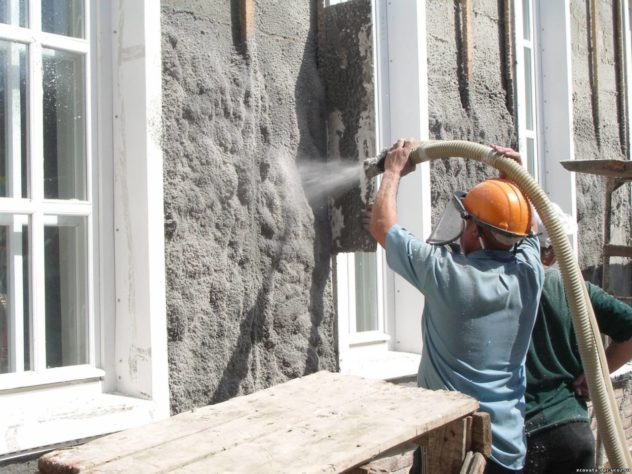 Ecowool was first produced in Finland. The harsh climate of this country did not affect the material from cellulose and antiseptics. Today, ecowool is successfully used in different climatic zones. In order to fix it from the outside, a vapor barrier layer is not required. Application methods: adhesive, inflatable using special equipment and bulk. A layer of 10 cm will reliably protect a log cabin from the cold. Cellulose wool is an environmentally friendly product and is completely safe for humans. It consists of paper production waste treated with antiseptics, which makes it resistant to pests and rodents. Ecowool belongs to low combustible products.
Ecowool was first produced in Finland. The harsh climate of this country did not affect the material from cellulose and antiseptics. Today, ecowool is successfully used in different climatic zones. In order to fix it from the outside, a vapor barrier layer is not required. Application methods: adhesive, inflatable using special equipment and bulk. A layer of 10 cm will reliably protect a log cabin from the cold. Cellulose wool is an environmentally friendly product and is completely safe for humans. It consists of paper production waste treated with antiseptics, which makes it resistant to pests and rodents. Ecowool belongs to low combustible products.
- Environmentally friendly product;
- Mold does not appear
- Do not gnaw mice;
- Noise-insulating qualities;
- High performance in thermal insulation;
- The ability to insulate both outside and inside;
- breathability;
- Slightly flammable;
- A light weight.
polyurethane foam
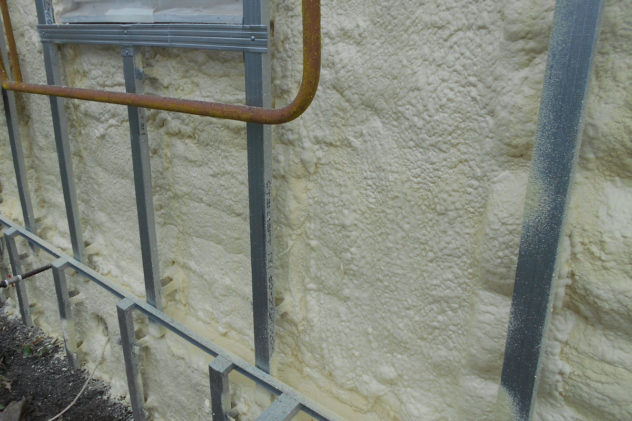 PPU is a modern product for building insulation. PPU is applied by professional craftsmen using special equipment. Initially, the components of this heat insulator are in different containers and only then are mixed in the apparatus. Warming occurs by spraying. In a short time, the outside walls of a wooden house are covered with a layer of polyurethane foam. And within 20 seconds it hardens. Such application has one important point - the absence of seams. Components repelling insects and mice are added to polyurethane foam. Manufacturers claim that polyurethane foam lasts up to thirty years.
PPU is a modern product for building insulation. PPU is applied by professional craftsmen using special equipment. Initially, the components of this heat insulator are in different containers and only then are mixed in the apparatus. Warming occurs by spraying. In a short time, the outside walls of a wooden house are covered with a layer of polyurethane foam. And within 20 seconds it hardens. Such application has one important point - the absence of seams. Components repelling insects and mice are added to polyurethane foam. Manufacturers claim that polyurethane foam lasts up to thirty years.
- Security;
- Soundproofing;
- Vapor barrier;
- It does not allow moisture to accumulate inside the premises;
- Not afraid of fire;
- Excellent adhesion parameters (sticks to surfaces and fills irregularities well).
Styrofoam
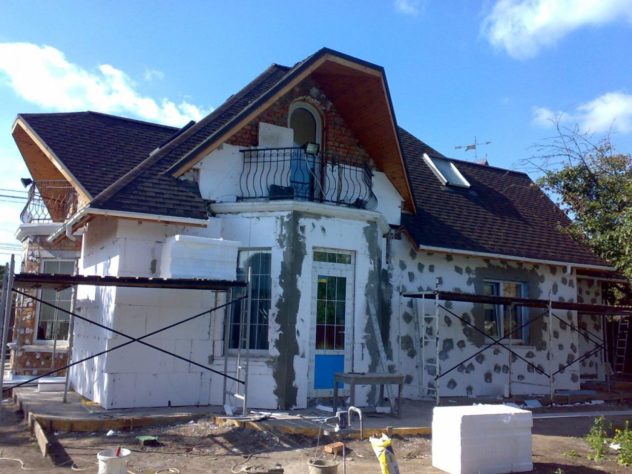 Often, when choosing a heater for a wooden house outside, the owners choose between polystyrene foam or mineral wool. But the advantages of polystyrene are as follows: it is excellent sound insulation, light weight and a long service life for 20 years. The material is produced in different sizes and densities. Styrofoam is used as a heater outside and inside the premises. Despite many positive characteristics, foam plastic has a high flammability class. Another significant disadvantage is the low hygroscopicity. Based on this, experts do not recommend insulating houses made of wood with polystyrene foam.
Often, when choosing a heater for a wooden house outside, the owners choose between polystyrene foam or mineral wool. But the advantages of polystyrene are as follows: it is excellent sound insulation, light weight and a long service life for 20 years. The material is produced in different sizes and densities. Styrofoam is used as a heater outside and inside the premises. Despite many positive characteristics, foam plastic has a high flammability class. Another significant disadvantage is the low hygroscopicity. Based on this, experts do not recommend insulating houses made of wood with polystyrene foam.
- It is well cut into the desired fragments;
- A light weight;
- Withstands temperature changes;
- Excellent soundproof qualities;
- Suitable for all climatic zones;
Extruded polystyrene foam
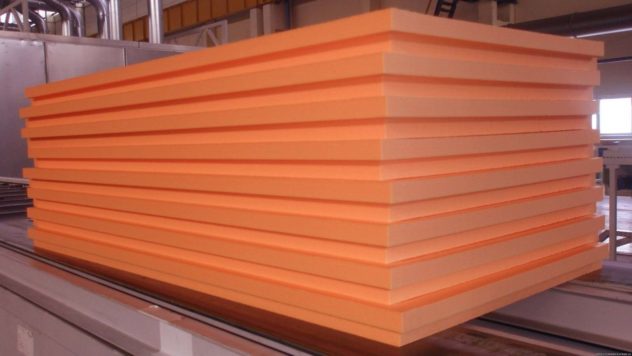 Expanded polystyrene refers to synthetic materials. This plastic is endowed with a uniform structure, in which there are small closed cells, which determines high thermal insulation parameters. But such a disadvantage as low vapor permeability makes it unclaimed as a heater for wooden houses. It is mainly used for warming garages, foundations, septic tanks, roofs.
Expanded polystyrene refers to synthetic materials. This plastic is endowed with a uniform structure, in which there are small closed cells, which determines high thermal insulation parameters. But such a disadvantage as low vapor permeability makes it unclaimed as a heater for wooden houses. It is mainly used for warming garages, foundations, septic tanks, roofs.
- Low price;
- Durability;
- Good for processing.
Penofol
Penofol is one of the most advanced insulation products. One of its subspecies has a special substrate consisting of polished foil. With the help of it, heat is reflected and does not go beyond the walls of the house. This action resembles the work of a thermos. Due to this, a log house insulated from the outside with penofol retains heat in the winter months, and keeps cool in the summer.
peat blocks
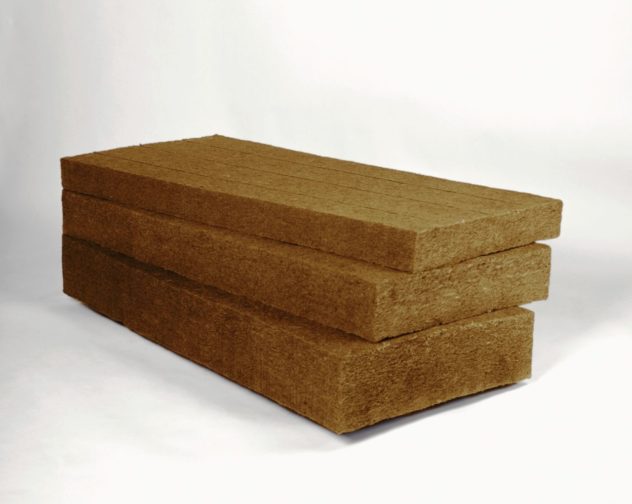 To obtain blocks, peat is mixed with sand, sawdust, or wood shavings. The resulting product is environmentally friendly and is used as a heater. So that a wooden house breathes, it is quite possible to insulate it from the outside with peat blocks. Manufacturers of these products give a guarantee on the operation of peat blocks for a period of more than 70 years. And their heat-insulating properties are equal to the parameters of silicone bricks. The strength of peat blocks is similar to some building materials, and load-bearing walls are also erected from them.
To obtain blocks, peat is mixed with sand, sawdust, or wood shavings. The resulting product is environmentally friendly and is used as a heater. So that a wooden house breathes, it is quite possible to insulate it from the outside with peat blocks. Manufacturers of these products give a guarantee on the operation of peat blocks for a period of more than 70 years. And their heat-insulating properties are equal to the parameters of silicone bricks. The strength of peat blocks is similar to some building materials, and load-bearing walls are also erected from them.
- Good sound insulation;
- Bactericidal properties (no mold without additional processing);
- Do not rot;
- They don't ignite.
fibreboard
 This material is used to insulate walls from the outside. Fibreboard boards are made from recycled wood. To do this, the raw material is crushed into chips, and then processed to a fibrous state, after which water is added to the resulting mass and dried. The whole process takes place without the introduction of formaldehyde resins. Fibreboards are a good external insulation for the walls of any buildings, and in particular wooden houses.
This material is used to insulate walls from the outside. Fibreboard boards are made from recycled wood. To do this, the raw material is crushed into chips, and then processed to a fibrous state, after which water is added to the resulting mass and dried. The whole process takes place without the introduction of formaldehyde resins. Fibreboards are a good external insulation for the walls of any buildings, and in particular wooden houses.
- Environmental friendliness;
- Strength;
- Hygroscopicity;
- Heat resistance;
- Soundproof qualities;
- Used as a heater and as a cladding.
Cork
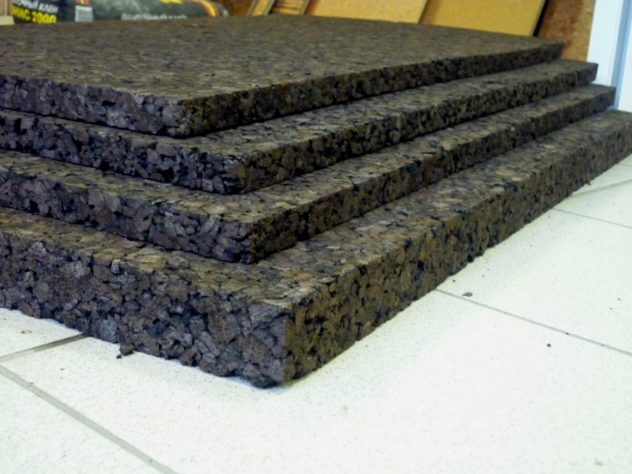 In view of the fact that the cost of this product is quite high, it is not often used as a heat-insulating product. Cork sheets are made from the bark of the cork tree. It is produced by grinding and heating the fibers. The connecting link in the production of boards is a sticky substance called suberin. Previously, cork was used as a finish for music studios as a powerful sound absorber.
In view of the fact that the cost of this product is quite high, it is not often used as a heat-insulating product. Cork sheets are made from the bark of the cork tree. It is produced by grinding and heating the fibers. The connecting link in the production of boards is a sticky substance called suberin. Previously, cork was used as a finish for music studios as a powerful sound absorber.
It is not for nothing that cork is considered one of the best heaters used for the outer walls of wooden houses. Cork is a product that can be used for a long time. And in the work, cork sheets have established themselves as a light and pliable material. A log house insulated with cork sheets will not only retain heat well, but also be reliably protected from pests.
- Cork sheets insulate the walls both outside and inside
- Doesn't rot
- Doesn't mold
- Long service life
- Excellent insulation
- decorative look
It should be noted that cork sheets, fibreboard, peat blocks, ecowool are organic heaters, naturally, the price for them will be higher than for synthetic products. At the same time, they are not inferior to mineral wool and polyurethane foam in such parameters as thermal insulation, sound insulation, durability, air permeability.



